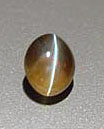



Chatoyance is the term for shimmering or silky reflections seen on the surface of a gem. This effect is created by light reflecting from fibrous inclusions. When these inclusions are parallel to each other and occur in sufficient quality and quantity, and when the gem is cut so as to align them properly, then a single reflection centered on the cabochon dome is formed which is referred to as a cat'seye. Many gem species have cat'seye varieties, including (but not limited to ) apatite, actinolite, beryl, chrysoberyl, Kornerupine, tourmaline, quartz, sillimanite, moonstone, opal and zircon.
A related phenomenon, asterism, or star effect, is created when the parallel fibers lie in different crystal planes relative to each other and is really just a case of 2 or 3 centered cat'seyes visible at the same time. The finer and more completely aligned the fibers, the stronger the cat'seye effect will be. The shape of cat'seye stones is nearly always round or oval and the cabs are generally cut with a high dome. All other factors being equal, the higher the dome of the cab, the stronger the eye.
As the cat'seyes of antiquity, only chrysoberyl cat'seyes are properly referred to as "cat'seye" with no modifier. Especially popular in the Orient, both the darker "honey" and lighter "lemon" colors are popular. Traditionally men have favored honey and women, lemon. All other species of cat'seyes should be given varietal designations like cat'seye tourmaline, cat'seye scapolite, etc.
Sunlight or a single overhead light source produces the best effect, and new owners are sometimes disappointed that the eye that they saw so clearly in the photo or in the showroom can't be seen clearly in dimly lit rooms or in those with multiple, diffuse light sources, like overhead fluorescents. Savvy buyers of these stones often carry a penlight to check out the sharpness of the eye of stones they are considering.
Some pieces show a highly desirable effect referred to as "milk and honey" where cat'seye gems lighted from the side split into a light and dark half. Also occasionally seen is the "opening and closing" effect where pinpoint light sources held above and then pulled apart to light both sides, causes the eye to split into two lines which follow the light sources.
The vast majority of cat'seye gems have been native cut with uneven bottoms, but this is not necessarily a sign of haphazard work or poor lapidary skills. Specialists in cutting these gems are great masters at revealing and centering an eye, which frequently necessitates such unevenness. Care should be taken in setting such as stone to provide cushioning and leveling material underneath.







The value of a cat'seye gem is, related to both the inherent value of the gem species, and the fineness of the cat'seye display. The most highly valued species is chrysoberyl, with large transparent, top quality gems commanding several thousand dollars per carat; while even the finest quality cat'seye quartz can be had relatively inexpensively. In general terms, rich color, high transparency and distinctness of the eye enhance the value. Milk and honey effect and opening and closing of the eye also raise the value of a cat'seye stone.